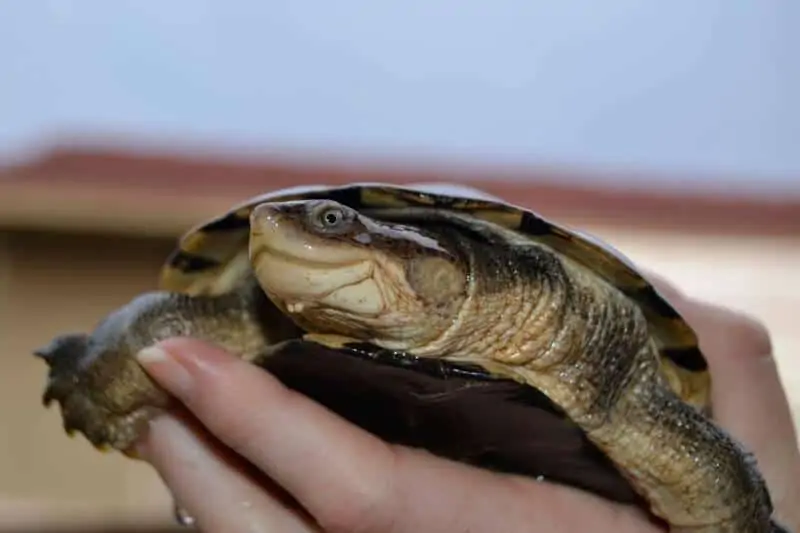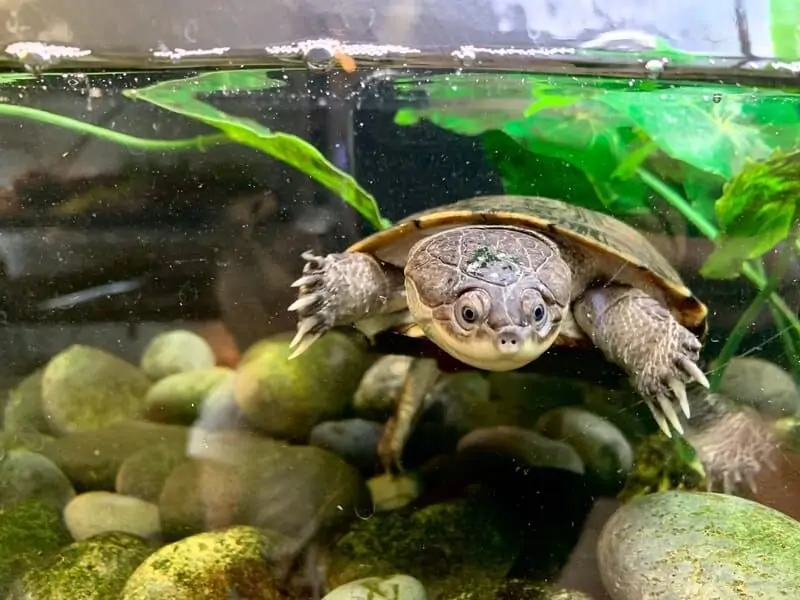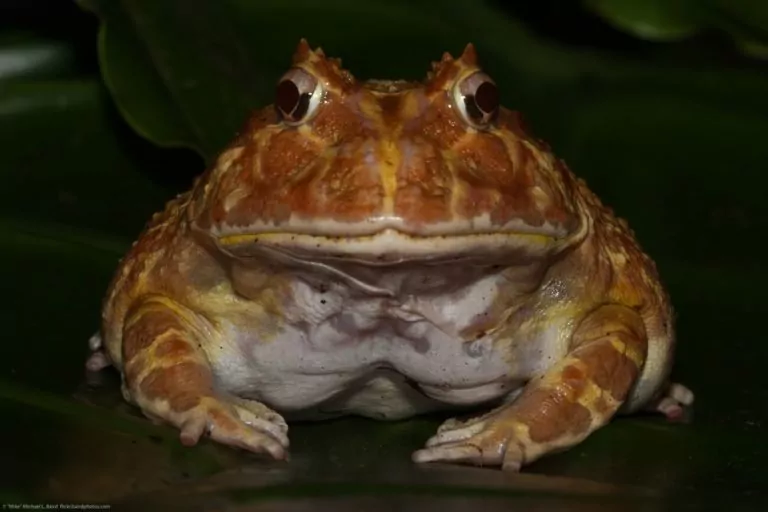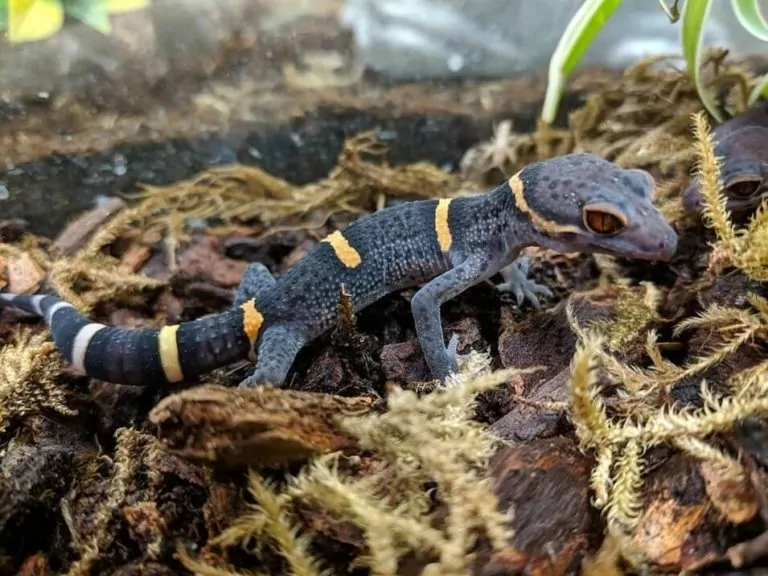African sideneck turtles are adorable reptiles that many people consider owning. Their unique face and playful behavior has made them a favorite among turtle-lovers!
This African sideneck turtle care sheet will cover all of the essential information you need to know if you want these reptiles to thrive. Tank setup, food, size, and lifespan are just some of the topics you’ll learn about!
Table of Contents
Species Summary
The African sideneck turtle (Pelusios castaneus) is an aquatic reptile with some unique characteristics. It’s on the bigger end of the size spectrum, outgrowing some more widespread water-dwelling pet turtle species. While that does lead to more challenges, African sidenecks are manageable for both newbies and season reptile-keepers.
As this turtle’s common name would indicate, they come from the warm climates of Africa. More specifically, they live along marshes, lakes, and lagoons throughout the western regions of sub-Saharan Africa.
Curious and active, the African sideneck turtle can be a joy to own. Its quirky appearance and playful attitude ensure that you never have a dull moment!
Appearance & Colors
This species is appropriately named for its unique neck. It’s considerably longer than other turtles. Their necks are so long that they are unable to retract their head into their shell fully.
Instead, they must tuck the head to the side. That’s why they have their distinct name.
Expert Tip: While the long neck might seem like a disadvantage, it can prove helpful in sticky situations. Should the African sideneck ever find itself turned upside-down, they can use their strong neck muscles to turn over.
Beyond that defining characteristic, African sideneck turtles have several eye-catching physical features. The shell is flat and lacks that dome-like shape you see with land-dwellers. Most specimens have dark brown or green carapaces.
Meanwhile, the underbelly is dark gray. Gray, olive-green, and brown hues appear on the skin. You may even see some accents of black here and there.
If you look closely at the turtle’s face, you’ll notice one of the “cutest” features this species has. Its mouth is upturned, creating a perpetual grin. Pair that with the large, rounded eyes, and you have a reptile that looks like it came straight from a cartoon!
Two small barbels extend from the lower jaw. They’re sensory organs that help the turtle get around.
Like most aquatic turtle species, the African sideneck has webbed feet. However, they’re equipped with long and sharp claws.
African Sideneck Turtle Lifespan
If you want a long-living pet reptile, these turtles are an excellent choice. The average African sideneck turtle lifespan is between 25 and 50 years! In some cases, they may even live beyond the five-decade mark!
African sideneck turtles are a big commitment. They can stay with you for several decades, so providing the best care possible is paramount.
As always, there are no guarantees when you’re dealing with a living animal. Genetics could play a role in premature death. The same goes for poor husbandry.
The best thing you can do is remain vigilant about meeting your turtle’s needs. Proper African sideneck turtle care requires you to take them to an exotic animal vet and work hard to maintain habitat conditions. In doing so, your odds of having a happy and healthy turtle for years to come are much higher.
Average Size
The typical African sideneck turtle size can measure anywhere between seven and 12 inches long when fully grown.
Sexual dimorphism is subtle in terms of appearance. However, one of the easiest ways to tell males and females apart is by looking at their size.
Females are the larger of the two. They usually reach lengths of eight to 12 inches. On the other hand, males typically don’t get any bigger than 10 inches.
African Sideneck Turtle Care
African sideneck turtle care requires you to understand a number of different things. In addition to providing a balanced diet, you have to recreate these turtle’s natural habitat as closely as possible.
These reptiles are from sub-Saharan Africa, so the standard living conditions of your home aren’t going to cut it. The good news is that these turtles are relatively easy to take care of as long as you’re willing to put in the work.
Study the African sideneck turtle care guidelines below to provide the best life possible for your new pet reptile.
Tank Size
Creating a suitable enclosure for this turtle can be tricky. African sidenecks are an aquatic species, but they also need plenty of access to dry land for basking.
For a single adult African sideneck turtle, herpetology enthusiasts typically recommend a tank with no less than 40 gallons of volume. An aquarium of that size should support a turtle’s life. However, it’s always better to go bigger when possible.
The ideal tank size for an adult African sideneck turtle is closer to 75 gallons. A standard glass aquarium will work fine. But instead of filling it all the way, aim for half or three-quarters full of water.
The rest should be open-air space and basking perches.
If you plan on keeping a small group of turtles together, go even larger! A small group will need an area that’s about six feet long by three feet wide. Tanks that hold upwards of 175 gallons are usually the go-to for collectors looking to house multiple African sidenecks in one enclosure.
Expert Tip: No matter which type of habitat you use or its size, make sure to invest in a tight-fitting lid. These reptiles are surprisingly skilled escape artists!
Habitat Setup
Like any other animal living in captivity, establishing a habitat setup that mimics the environment where they would live in the wild is important.
Once you fill the tank up with water, install a floating dock, stationary perch, or climbable rocks. African sidenecks spend a lot of time in the water, but they must have the ability to climb out when they want. If you have a large enclosure, you can create a natural slope to split the environment between swimming and land spaces.

So, what about the substrate? Realistically, you don’t need any substrate at all. A bare-glass bottom will do just fine for this species.
That said, you can use substrate material if you want to go the extra mile with decor. Sand and large gravel is perfect for anchoring plants and creating a realistic lake bottom. Whatever you use, ensure that the substrate doesn’t pose a choking threat.
Next, add some plants. Both artificial and live plants work well here. The vegetation provides some natural coverage and adds enrichment to the turtle’s life. You can also implement items the turtle would encounter at the bottom of a lake and river bed.
For example, driftwood, rocks, and other items help to sell the illusion of nature even more.
Temperature & Lighting
Investing in a high-quality lighting system is an important part of African sideneck turtle care. Lighting serves two purposes. Not only does it simulate a typical day and night cycle, but it also warms the environment.
A fluorescent and incandescent lighting system will take care of the heat. It’ll heat both the ambient air and the water. We’ll get into the details of the water condition in a bit.
For now, focus on getting ambient air temperatures just right. Like all reptiles, a temperature gradient is crucial to promote efficient thermoregulation.
On the cooler end, the air inside should be in the low 80s at all times. Use a thermometer to get things just right, as significant dips could cause health troubles.
For the hotter side of the environment, use a basking lamp. Basking lamps create a focused hot area where the turtle will warm their bodies up as if they were basking in the sun. Place the light above a dry-land area of the tank and raise the temperature between 95 and 100 degrees Fahrenheit.
Another crucial element to add is UV lighting. African sideneck turtles need exposure to UV rays to metabolize calcium efficiently. Without it, they could encounter a world of hurt. More on that later.
Install a full-spectrum UVB light. Place it about 12 inches above the land portion of the enclosure and position it so that light reaches every corner. Set it on a 12-hour timer, and your turtle will have a true-to-life day and night cycle!
Expert Tip: Make sure to replace UV bulbs every six months or so to make sure your turtles are fully benefiting from their effects.
Humidity
Usually, humidity is a significant factor when caring for reptiles. Luckily, it’s not too much of a worry with the African sideneck turtle.
They live most of their lives in water. The water portion of the enclosure is more than enough to keep the air nice and muggy. As long as you maintain water levels, your turtle should be fine in the humidity department.
Water
Now, let’s move onto the water portion of the enclosure!
Because these reptiles are aquatic, paying attention to water parameters is one of the most important parts of African sideneck turtle care! These creatures spend most of their lives swimming.
Install a separate underwater thermometer and adjust the water temperature to remain constant between 70 and 75 degrees Fahrenheit. The lighting system will do most of the heavy lifting here. But if you want more precision, consider using a submerged heater.
Submerged heaters are also great for maintaining healthy temperatures at night when ambient conditions tend to drop.
Test the water regularly and aim for a relatively neutral pH balance. Slight acidity is acceptable, but don’t let the water go below 6.5 on the pH scale.
Finally, don’t forget about filtration! Thanks to their large size, African sideneck turtles can produce a lot of waste. If you don’t filter the water, you’d have to change it every week to avoid health complications.
Expert Tip: Most filtration systems will serve you well as long as it’s capable of processing all the water volume. However, most herpetology enthusiasts recommend using a high-powered canister filter with a flow rate of at least 350 gallons per hour for the best results.
Food & Diet
Natural omnivores, African sideneck turtles eat a wide range of foods in the wild. They’ll eat everything from plants to insects that fly near the water’s surface.
In captivity, a varied diet is paramount. You must provide many different kinds of food to ensure that your turtle consumes a broad range of nutrients and minerals.
When they’re young, African sidenecks prefer a diet that leans more on the carnivorous side. Juveniles are still growing, so they need insects and protein-based snacks to support their changing bodies.
That preference changes as they approach adulthood. Adults tend to gravitate towards plant-based foods. Either way, variety is key!
Here are common foods that most African sideneck turtles will not hesitate to eat.
- Snails
- Clams
- Fish pieces
- Earthworms
- Crickets
- Crustaceans
- Dubia roaches
- Mealworms
- Krill and shrimp
- Bloodworms
- Mussels
- Mustard greens
- Dandelion greens
- Collard greens
- Romaine lettuce
- Red-leaf lettuce
- Carrots
- Mixed vegetables
Expert Tip: Some owners like to feed animal-based proteins like chicken or beef. However, the jury is still out on the safety of that. While some might see no problem in it, the risks of parasites and illness are still present.
For this reason, it’s better to stick to marine seafood and insects for protein.
You can also find commercial turtle pellets. Those work well, but they should be a part of the diet mix rather than the sole food you provide.
Feed your African sideneck turtle every two or three days. Provide only enough food as they can eat in a minute or two.
It’s a good idea to provide vitamin supplements every few feedings. Vitamin A, Vitamin D3, and calcium supplements are widely available. They usually come in dust form, making it easy to coat the food. All-in-one multivitamin supplements are available as well.
Feeding sessions can be messy. If you’re worried about the cleanup afterward, you can move your turtle to a separate feeding tank. Some reptile enthusiasts use this technique to preserve the water conditions of the main enclosure.
Potential Health Issues
African sideneck turtles can suffer from a myriad of health problems. While there are no species-specific issues to worry about, the aquatic nature of this animal does present some challenges that new owners might not be used to.
One major issue among these turtles is parasites. Parasitic creatures dwell in the waters of their natural habitat. Those body invaders inevitably tag along when moved into domestication, posing problems for pet stores and keepers.
Expert Tip: Even if your turtle doesn’t have parasites when you buy them, they could quickly become a problem later. The best way to avoid them is to test the tank water regularly. Maintain the filtration system and keep a close eye on the water quality.
If parasites are a problem, you might notice tiny worms floating in the water column. Most turtles won’t present any physical symptoms of a parasitic infection, so it’s essential to go to an exotic animal vet for testing. Fortunately, parasites are usually easy to treat with the proper medication.
Respiratory infections are common with African sideneck turtles as well. Symptoms often include difficulty breathing, mucus around the nasal passages, and slight inflammation of the mouth tissue.
The best way to avoid respiratory infections is to maintain water and air conditions. If things go too far out of the “safe-zone,” issues are bound to occur. Keep up with filtration as well, as bacteria can run rampant in dirty tanks.
Finally, there’s the risk of metabolic bone disease, vitamin deficiencies, and even shell rot. Metabolic bone disease is a direct result of low calcium levels. Remember how we said that these turtles need UV light to metabolize calcium?
Without it, the body’s natural calcium supply dips too low for comfort. The bones become brittle, making them prone to breakage. It’s a painful disorder that can severely shorten a turtle’s life.
Avoid it by making sure that your UV lights are always working. Replace those bulbs every six months, and make sure to incorporate some Vitamin D3 supplements into your turtle’s diet.
Behavior & Temperament
Overall, African sideneck turtles make wonderful pets because of their relatively easy-going nature. They’re energetic and lively, showing interest in their surroundings. While many turtles bask in one spot, these creatures like to swim around and explore their habitat.
This reptile is also surprisingly social. The turtles are usually quite shy initially, choosing to hide out in the water and plants whenever you approach. However, they’ll “come out of their shell,” so to speak, the more you interact with them.
As they become more comfortable with their surroundings, they will be more active and explorative. Many will even acknowledge your presence, coming to the surface to look for food as you approach.
Quick Tip: It is possible to keep more than one African sideneck turtle together as tank mates. However, it’s best to keep males separated. They can show aggression towards one another, leading to injuries.
Handling Them
African sideneck turtles are more of a “look, don’t touch” kind of pet. They can handle occasional handling when it’s necessary. For example, they’ll accept handling when you must move them for feedings or tank maintenance.
But beyond that, it’s best to let the turtle do its own thing. These creatures stress pretty easily and are capable of delivering a painful bite if threatened.
On top of that, there’s the issue of bacteria. Turtles can carry salmonella bacteria, which is a pathogen that can cause health issues in humans.
Keep the handling to a minimum to keep everyone safe and happy. If you do need to touch your turtle, be gentle and wash your hands thoroughly afterward.
Closing Thoughts
Despite their aquatic nature, African sideneck turtle care is something that many owners can handle. Just study their requirements and commit the necessary amount of time to helping these reptiles thrive, and you’ll be fine!
However, we understand that you might have some questions after giving this care sheet a read. If so, send them over to us via our contact page and we’ll try to help you out as soon as possible.



